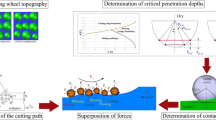Abstract
Grinding at the microscale is an essential process in view of its competitive edge over other processes in the fabrication of micro-sized features and parts. The quality of the parts produced by the microscale grinding process can be influenced by various factors related to the mechanical forces induced. Therefore, the predictive modeling of microscale grinding in the context of forces is useful to provide guidance for further development and optimization of this process. In this study, a new model to address mechanical and thermal interactions between the workpiece and an individual single grit on a microscale grinding wheel was developed. This developed model integrates the ploughing and associated friction effects and a moving heat source on the micro-grinding zone under given machining conditions to estimate the thermal effect in microscale grinding process. The ratio of heat partition into the workpiece in the thermal model was also experimentally calibrated using embedded thermocouple measurement followed by analytical calculations. This model quantitatively predicts microscale grinding forces incorporating material properties as functions of strain, strain rate, and temperature. In order to verify this developed model, the experiments based on a surface microscale grinding setup were performed for changing depths of cut. In addition to this, the sensitivity analysis of this model behavior was conducted to identify main effective factors. A comparison between the experiment data and predictions shows that the force model captures the main trend of the microscale grinding physics within the computed range of parameters.
Similar content being viewed by others
References
Backer WR, Marshall ER, Shaw MC (1952) The size effect in metal cutting. Trans ASME 74:61–74
Kopalinsky EM, Oxley PLB (1984) Size effects in metal removal processes. Inst Phys Conf Ser 70:389–396 Oxford, Engl
Hahn RS, Lindsay RP (1982a) Principles of grinding part 1. The metal removal parameter. Grinding: theory, techniques and trouble shooting. SME 3–10
Hahn RS, Lindsay RP (1982b) Principles of grinding part 2. The metal removal parameter. Grinding: theory, techniques and trouble shooting. SME 11–17
Hahn RS, Lindsay RP (1982c) Principles of grinding part 3. The wheel removal parameter. Grinding: theory, techniques and trouble shooting. SME 18–24
Hahn RS, Lindsay LP (1982d) Principles of grinding part 4. Surface finish, geometry, and integrity. Grinding: theory, techniques and trouble shooting. SME 25–35
Malkin S (1989) Grinding technology: theory and application of machining with abrasives. Horwood, New York
Lal G, Shaw M (1975) The role of grain top radius in fine grinding. J Eng Ind 1119–1125
Tönshoff H, Peters J, Inasaki I et al (1992) Modeling and simulation of grinding processes. Ann CIRP 42(2):677–688 doi:10.1016/S0007-8506(07)63254-5
Jaeger JC (1942) Moving sources of heat and temperature at sliding contacts. Proc R S NSW 76:203–224
Outwater JO, Shaw MC (1952) Surface temperatures in grinding. Trans ASME 74:73–81
Rowe WB, Black SCE, Mills B et al (1996) Analysis of grinding temperatures by energy partitioning. Proc Inst Mech Eng B J Eng Manuf 210:579–588
Xu X, Malkin S (2001) Comparison of methods to measure grinding temperatures. J Manuf Sci Eng 123:191–195 doi:10.1115/1.1369358
Hahn RS (1962) On the nature of the grinding process. Proceeding of the 3rd MTDR Conference, 1962, pp 129–154
Rowe WB, Black SCE, Mills B et al (1995) Experimental investigation of heat transfer in grinding. CIRP Ann Manuf Technol 44:329–332
Shaw MC (1950) A quantitized theory of strain hardening applied to the cutting metals. J Appl Phys 21:599 doi:10.1063/1.1699714
Masuko M (1956) Fundamental research on the metal cutting-second report. Bull Jpn Soc Mech Eng 22:371
Nakayama K (1968) Size effect in metal cutting force. J Eng Ind 90:119
Dinesh D, Swanminathan S, Chandrasekar S et al (2001) Symposium in fundamental issues in machining. Proceedings of ASME IMECE, 2001
Basuray PK, Misra BK, Lal GK (1977) Transition from ploughing to cutting during machining with blunt tools. Wear 43:341–349 doi:10.1016/0043-1648(77)90130-2
Liu K, Li X (2001) Modeling of ductile cutting of tungsten carbide. Trans North Am Manuf Res Inst SME 113:251–258
Son SM, Lim HS, Ahn JH (2005) Effects of the friction coefficient on the minimum cutting thickness in micro cutting. Int J Mach Tools Manuf 45:529–535 doi:10.1016/j.ijmachtools.2004.09.001
Keith RW (1997) Numerical scheme for extracting strength model coefficients from Taylor test data. Int J Impact Eng 19:797–810 doi:10.1016/S0734-743X(97)00015-8
Shaw M (1972) Fundamentals of grinding. Proceeding of the International Grinding Conference: New Developments in Grinding, Pittsburgh, Pennsylvania, 1972, pp 221–258
Sin H, Saka N, Suh NP (1979) Abrasive wear mechanisms and the grit size effect. Wear 55:163–190 doi:10.1016/0043-1648(79)90188-1
Goddard J, Wilman H (1965) A theory of friction and wear during the abrasion of metals. Wear 5:114–135 doi:10.1016/0043-1648(62)90235-1
Rowe WB, Morgan MN, Qi HS et al (1993) Effect of deformation on the contact area in grinding. CIRP Ann 42:409–412 doi:10.1016/S0007-8506(07)62473-1
Malkin S, Cook NH (1971) The wear of grinding wheels, part 2—fracture wear. J Eng Ind 93:1129–1133
Hou ZB, Komanduri R (2003) On the mechanics of the grinding process - Part I. Stochastic nature of the grinding process. Int J Mach Tools Manuf 43:1579–1593 doi:10.1016/S0890-6955(03)00186-X
Park HW (2008) Development of micro-grinding mechanics and machine tools, Ph.D. dissertation, Georgia Institute of Technology, Atlanta, USA
Author information
Authors and Affiliations
Corresponding author
Rights and permissions
About this article
Cite this article
Park, H.W., Liang, S.Y. Force modeling of microscale grinding process incorporating thermal effects. Int J Adv Manuf Technol 44, 476–486 (2009). https://doi.org/10.1007/s00170-008-1852-3
Received:
Accepted:
Published:
Issue Date:
DOI: https://doi.org/10.1007/s00170-008-1852-3




